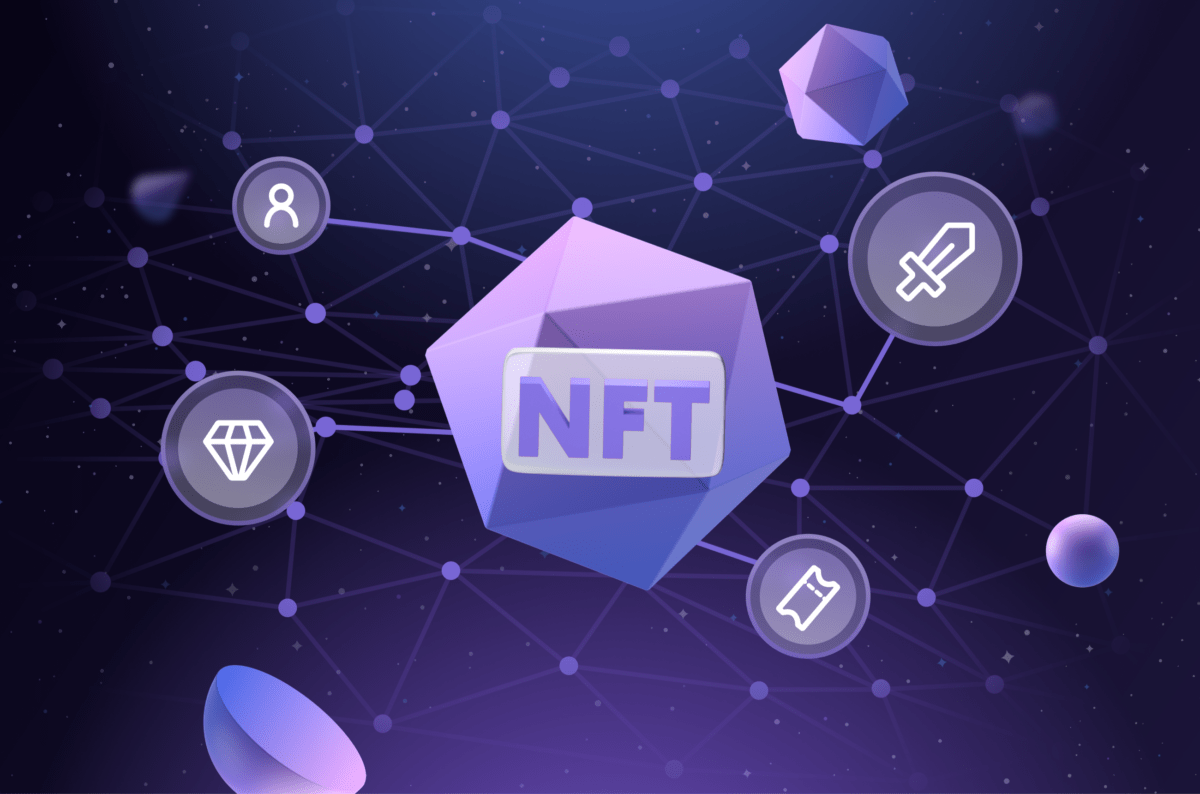How is Unlocking the World of NFT Trading: Decoding the Nuances Beyond NFT Sales

In the ever-evolving landscape of digital assets, Non-Fungible Tokens (NFTs) have emerged as a revolutionary force, reshaping the way we perceive and trade digital content. NFTs, often associated with digital art, music, and virtual real estate, have gained immense popularity, with artists, creators, and collectors participating in a vibrant ecosystem. However, beneath the surface of NFTs lies the nuanced realm of NFT trading, a domain that goes beyond the conventional act of selling digital tokens. In this comprehensive exploration, we delve into the intricacies of NFT trading, unraveling the distinctions that set it apart from the straightforward act of selling NFTs.
Understanding the Essence of NFTs:
 Before delving into the nuances of NFT trading, it’s imperative to grasp the essence of Non-Fungible Tokens. NFTs are unique digital assets that are indivisible and cannot be exchanged on a one-to-one basis like cryptocurrencies. Each NFT is distinct, carrying a unique identifier on the blockchain, often associated with ownership, authenticity, and provenance. These digital tokens have found applications across various domains, from digital art and collectibles to virtual real estate and gaming items.
Before delving into the nuances of NFT trading, it’s imperative to grasp the essence of Non-Fungible Tokens. NFTs are unique digital assets that are indivisible and cannot be exchanged on a one-to-one basis like cryptocurrencies. Each NFT is distinct, carrying a unique identifier on the blockchain, often associated with ownership, authenticity, and provenance. These digital tokens have found applications across various domains, from digital art and collectibles to virtual real estate and gaming items.
The Act of Selling NFTs:
At its core, selling NFTs involves the straightforward process of transferring ownership of a digital asset from one party to another in exchange for a cryptocurrency, typically Ethereum. The seller lists the NFT on a digital marketplace, sets a price, and interested buyers can purchase the NFT using cryptocurrency. The transaction is recorded on the blockchain, providing an immutable record of ownership transfer.
However, the simplicity of selling NFTs is just the tip of the iceberg in the expansive world of digital asset transactions. It sets the stage for the more intricate and dynamic activity known as NFT trading.
Also, read – The Uncertain Future Of NFT Trading Cards
Unveiling the Dynamics of NFT Trading:

In the ever-evolving landscape of blockchain and digital assets, Non-Fungible Tokens (NFTs) have emerged as a transformative force, ushering in a new era of ownership, creativity, and value in the digital realm. While the concept of selling NFTs marks the initial transactional step, the intricate and dynamic world of NFT trading takes this interaction to new heights. In this comprehensive exploration, we peel back the layers to unveil the dynamics of NFT trading, delving into the multifaceted ecosystem that extends far beyond the simple act of buying or selling digital tokens.
1. Primary Transaction vs. Secondary Market Dynamics:
At its core, NFT trading involves distinguishing between the primary sale of NFTs and the secondary market, each with its distinct dynamics. The primary transaction occurs when the creator or current owner sells an NFT for the first time. However, the secondary market opens up a world of possibilities as NFT holders trade assets amongst themselves. The secondary market introduces a layer of complexity where NFTs become commodities subject to supply and demand dynamics, influencing their perceived value.
2. Speculation and Investment Strategies:
NFT trading is inherently speculative, with participants strategically acquiring and trading tokens based on anticipated value appreciation. Traders may employ various investment strategies, analyzing factors such as the reputation of the creator, scarcity of the asset, cultural significance, or emerging trends. This speculative dimension introduces an element of risk and reward, adding depth to the trading experience beyond the simple transfer of ownership.
3. Marketplaces and Platform Diversity:
The diversity of digital marketplaces and platforms plays a pivotal role in shaping NFT trading dynamics. While well-known platforms like OpenSea, Rarible, and Mintable cater to a broad range of digital assets, specialized marketplaces focus on specific niches, such as art, music, or gaming. The choice of marketplace significantly influences how NFTs are traded, discovered, and valued within their respective communities.
4. Dynamic Pricing Strategies:
Unlike traditional markets, NFT trading often involves dynamic pricing strategies that go beyond fixed prices. Sellers can choose auction formats, set reserve prices, or employ various creative pricing mechanisms. The dynamic nature of the market, coupled with the uniqueness of each NFT, contributes to a fluid pricing landscape. Traders need to navigate these pricing strategies, considering recent sales, market trends, and the perceived value of the digital asset.
5. Community Engagement and Social Influence:
Community engagement is a cornerstone of NFT trading, where participants actively interact within communities centered around specific artists, projects, or genres. Social platforms, forums, and collaborative events become spaces for traders to discuss, share insights, and collaborate. The collective influence of these communities often plays a significant role in determining the perceived value and demand for specific NFTs.
6. Decentralized Exchanges and Liquidity:
Decentralized exchanges (DEXs) have extended their influence into the realm of NFT trading, providing decentralized platforms for buying and selling digital assets. Platforms like Uniswap and Sushiswap, known for decentralized finance (DeFi), contribute to the liquidity of NFTs, offering alternatives to traditional centralized exchanges. NFT traders benefit from increased liquidity and a more decentralized trading experience.
7. Fractionalized Ownership and Accessibility:
An innovative aspect of NFT trading involves fractionalized ownership, enabling users to own fractions of high-value NFTs. Platforms like Fractional facilitate the fractionalization of NFTs, making them more accessible to a broader audience. This democratization of ownership introduces a layer of financial inclusivity and investment diversification within the NFT space.
8. Smart Contracts and Programmable Trading:
Smart contracts, a hallmark of blockchain technology, play a crucial role in NFT trading. These self-executing contracts enable programmable trading mechanisms, including automated auctions, royalties for creators on secondary sales, and programmable ownership rules. The utilization of smart contracts introduces automation and customization, allowing for a more sophisticated and flexible trading experience.
9. Market Dynamics and Trends:
The NFT market is characterized by dynamic shifts and evolving trends. The popularity of specific artists, the emergence of new projects, and technological advancements influence market dynamics. Staying abreast of these trends is essential for traders seeking to navigate the market effectively, anticipate shifts, and strategically position themselves in the evolving landscape.
10. Challenges and Opportunities:
While NFT trading presents unprecedented opportunities, it also comes with challenges. Scalability concerns, environmental considerations, and the potential for market saturation are among the challenges traders and platforms face. Navigating these challenges requires a combination of technological innovation, regulatory awareness, and community collaboration to sustain a healthy and vibrant NFT ecosystem.
Daily ranking of NFT trading platform (#EthereumNFTs)
📅Dec 5, 2023 (UTC)@blur_io @opensea @openseapro @the_x2y2 @okxweb3 @NFTX_ @sudoswap @AlphaSharksNFT @reservoir0x @ensvision @AlienSwap_NFT @Element_Market @LooksRare#NFTs #NFTFollowTrain #NFTCommuntiy $wom pic.twitter.com/0m4ODNvmuK— Stalker – 𝕏 🟧 🟪 (@stalker4NFT) December 6, 2023
Top 10 Key Differences Between NFT Trading and NFT Selling

The realm of Non-Fungible Tokens (NFTs) has grown exponentially, evolving beyond simple transactions to complex ecosystems of trading, speculation, and community engagement. While the act of selling NFTs initiates the ownership transfer, NFT trading unfolds as a dynamic interplay of market dynamics, speculative strategies, and community involvement. In this exploration, we uncover the top 10 key differences between NFT trading and the more straightforward concept of selling NFTs.
1. Primary vs. Secondary Market:
1.1 Selling NFTs:
- Selling NFTs primarily involves the initial transaction where the creator or current owner sells the digital asset to a buyer.
- The transaction occurs on the primary market, marking the first instance of ownership transfer from the creator to a new owner.
1.2 NFT Trading:
- NFT trading extends into the secondary market, where NFT holders can trade assets amongst themselves.
- The secondary market introduces a dynamic environment influenced by supply and demand, market trends, and the perceived value of NFTs.
2. Transaction Complexity:
2.1 Selling NFTs:
- Selling NFTs is a relatively straightforward process where the seller lists the digital asset on a marketplace, sets a price, and interested buyers can purchase it.
2.2 NFT Trading:
- NFT trading involves a more complex set of activities, including speculation, dynamic pricing, and engagement in the secondary market.
3. Marketplace Diversity:
3.1 Selling NFTs:
- Selling NFTs often takes place on well-known platforms like OpenSea, Rarible, or Mintable, catering to a broad range of digital assets.
3.2 NFT Trading:
- NFT trading extends beyond conventional marketplaces to specialized platforms and communities catering to specific niches, genres, or artists.
4. Speculation and Investment:
4.1 Selling NFTs:
- The act of selling NFTs may not inherently involve speculative considerations, as it is a one-time transaction.
4.2 NFT Trading:
- NFT trading introduces speculation and investment strategies where participants strategically acquire and trade assets based on anticipated value appreciation.
5. Dynamic Pricing Strategies:
5.1 Selling NFTs:
- Selling NFTs typically involves fixed prices set by the seller, with buyers agreeing to the listed price.
5.2 NFT Trading:
- NFT trading introduces dynamic pricing strategies, including auctions, reserve prices, and other creative mechanisms influenced by market dynamics.
6. Community Engagement:
6.1 Selling NFTs:
- Selling NFTs may not inherently involve active engagement with communities, as it is a transactional process between the buyer and seller.
6.2 NFT Trading:
- NFT trading often involves active participation in communities, forums, and events where traders discuss, share insights, and collaborate.
7. Liquidity and Decentralized Exchanges:
7.1 Selling NFTs:
- Selling NFTs on centralized platforms is the norm, where liquidity is dependent on the user base of the specific marketplace.
7.2 NFT Trading:
- NFT trading extends to decentralized exchanges (DEXs), contributing to increased liquidity and a more decentralized trading experience.
8. Fractionalized Ownership:
8.1 Selling NFTs:
- Selling NFTs typically involves the transfer of full ownership to a single buyer.
8.2 NFT Trading:
- NFT trading introduces the concept of fractionalized ownership, allowing users to own fractions of high-value NFTs.
9. Smart Contracts and Programmable Trading:
9.1 Selling NFTs:
- Selling NFTs involves straightforward ownership transfers without the need for complex programmable features.
9.2 NFT Trading:
- NFT trading leverages smart contracts for programmable features, including automated auctions, royalties, and customizable ownership rules.
10. Market Dynamics and Trends:
10.1 Selling NFTs:
- Selling NFTs may not inherently involve considerations of market dynamics or trends, as it is a one-time transaction.
10.2 NFT Trading:
- NFT trading requires participants to stay abreast of market dynamics, emerging trends, and shifts in demand that influence trading decisions.
Conclusion:
In conclusion, the dynamics of NFT trading represent a multifaceted and ever-evolving ecosystem that transcends the conventional concept of buying and selling digital assets. NFT trading involves navigating the intricacies of primary and secondary markets, embracing speculation and investment strategies, engaging with diverse marketplaces, understanding dynamic pricing mechanisms, and participating in vibrant communities. The advent of decentralized exchanges, fractionalized ownership, smart contracts, and the influence of trends further enrich the trading experience.
As the NFT landscape continues to mature, participants in NFT trading must adapt to shifting dynamics, seize emerging opportunities, and contribute to the sustainable growth of the digital asset ecosystem. Whether you’re an artist, collector, or trader, unveiling the dynamics of NFT trading opens doors to a world where digital assets are not only bought and sold but actively traded, shaping the narrative of a decentralized and interconnected digital economy.



























































